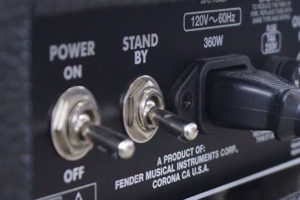Should we leave the Amp on standby?
Brian Rois | Jun 24, 2018 | Comments 0

In most tube guitar amplifiers, the standby feature is largely unnecessary. By now, the standby debate has largely been settled: “cathode stripping” doesn’t happen in the tubes that are commonly used in guitar amplifiers, so there’s no need to wait for the heaters to warm up before applying high voltage (B+) to the tubes.
The reality is modern guitar amplifiers generally have much more filtering in the high voltage supplies than their vintage counterparts, so the B+ in later stages comes up slowly over many seconds anyhow. In amps with tube rectifiers, the rectifier’s themselves start up slowly, but also their high resistance creates a long time constant with the main filter cap. In other words, tubes rarely, if ever, see the full B+ with cold heaters!
For those of you that do use your standby switch, this is why it takes a while before the amp comes to life and volume gradually ramps up. Most people think this with the heaters warming up; it’s not, it’s the B+.
There’s actually more harm done to the tubes by using the standby switch…this damage is caused by something called “cathode poisoning”. Cathode poisoning occurs when the cathode is heated in the absence of plate voltage for long periods of time. When poisoning occurs, the cathode’s chemical structure changes and it becomes less able to emit electrons. If the cathode becomes sufficiently ‘poisoned’, the tube will become noisy and its ability to amplify will diminish.
We should, however, pay attention to why that amp has a standby switch in the first place. It’s safe to say the majority of the amplifier’s out there have standby switches because of the customer’s expectation. Standby switches are commonplace, so to not include one might seem weird. It could also be that the designer doesn’t know or even care that the traditional standby is irrelevant…they could just like them for historical or aesthetic reasons.

At Black Widow, I personally design our products with standby switches. Now, before I’m called a hypocrite for just telling you two paragraphs ago that it is better not to use the standby, our standby switches are completely different than the traditional designs.
Usually, the standby switch is wired between the B+ transformer winding and the rectifier and simply turns off the high voltage to the tubes.
But ours do three things. First, we lower the heater voltage to about 60% of its normal operating voltage. This keeps the tubes warmed up, but completely eliminates the risk from cathode poisoning. The B+ is also turned off, AND we turn off our auxiliary supply. We do this because these supplies are the biggest energy consumers in our products; we feel being energy responsible is important these days.
So in our products, the standby is actually designed to be used in the traditional way: short breaks. Yet in this case, you won’t be hurting your tubes, nor will you be using any more energy than is necessary to keep the unit ready to go.
So, should we leave our amps on Standby?
It all depends.
Leaving the standby switch off (play mode) is not going to hurt anything. Taking small set breaks and using the standby switch is not going to hurt anything since cathode poisoning takes hours to begin occurring. And even then, it’s not like you will leave your amp in standby for an hour and you’ll come back to dead tubes. This happens gradually…just don’t do it every day and expect your tubes to last.
But as guitar amp designs get more and more advanced, you’ll likely see a change in the way standby switches are implemented. You may even see them disappear. But it’s ALWAYS best to consult the manual or manufacturer and follow their recommendations…you can never know the designer’s intentions just by observing the presence of a switch on the front panel.
Tiny URL for this post:
Filed Under: Featured • Commentary / Editorials
About the Author: Brian Rois is the brainiac behind Analog Amp Modeling. He is the founder and product designer at Black Widow Audio Designs and loves to talk gear with anyone. When not designing, he can be found making his world famous artisanal pizza, which is only world famous because family in England thinks “it’s OK”.




















